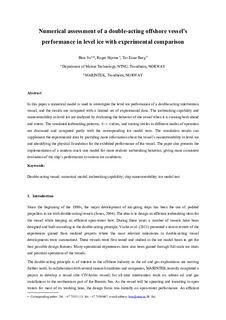| dc.contributor.author | Su, Biao | |
| dc.contributor.author | Skjetne, Roger | |
| dc.contributor.author | Berg, Tor Einar | |
| dc.date.accessioned | 2017-12-05T07:28:31Z | |
| dc.date.available | 2017-12-05T07:28:31Z | |
| dc.date.created | 2014-06-29T11:43:38Z | |
| dc.date.issued | 2014-10 | |
| dc.identifier.citation | Cold Regions Science and Technology. 2014, 106-107 96-109. | nb_NO |
| dc.identifier.issn | 0165-232X | |
| dc.identifier.uri | http://hdl.handle.net/11250/2469155 | |
| dc.description.abstract | In this paper a numerical model is used to investigate the level ice performance of a double-acting intervention vessel, and the results are compared with a limited set of experimental data. The icebreaking capability and maneuverability in level ice are analyzed by evaluating the behavior of the vessel when it is running both ahead and astern. The simulated icebreaking patterns, h–v curves, and turning circles in different modes of operation are discussed and compared partly with the corresponding ice model tests. The simulation results can supplement the experimental data by providing more information about the vessel's maneuverability in level ice and identifying the physical foundation for the exhibited performance of the vessel. The paper also presents the implementation of a random crack size model for more realistic icebreaking behavior, giving more consistent evaluation of the ship's performance in various ice conditions. | nb_NO |
| dc.language.iso | eng | nb_NO |
| dc.relation.uri | http://www.sciencedirect.com/science/article/pii/S0165232X14001220# | |
| dc.rights | Navngivelse-Ikkekommersiell-DelPåSammeVilkår 4.0 Internasjonal | * |
| dc.rights.uri | http://creativecommons.org/licenses/by-nc-sa/4.0/deed.no | * |
| dc.subject | Arktisk teknologi | nb_NO |
| dc.subject | Arctic Technology | nb_NO |
| dc.subject | Double-acting vessel | nb_NO |
| dc.subject | Numerical model | nb_NO |
| dc.subject | Icebreaking capability | nb_NO |
| dc.subject | Ship maneuverability | nb_NO |
| dc.subject | Ice model test | nb_NO |
| dc.title | Numerical assessment of a double-acting offshore vessel's performance in level ice with experimental comparison | nb_NO |
| dc.type | Journal article | nb_NO |
| dc.type | Peer reviewed | nb_NO |
| dc.description.version | acceptedVersion | nb_NO |
| dc.subject.nsi | VDP::Skipsteknologi: 582 | nb_NO |
| dc.subject.nsi | VDP::Ship technology: 582 | nb_NO |
| dc.source.pagenumber | 96-109 | nb_NO |
| dc.source.volume | 106-107 | nb_NO |
| dc.source.journal | Cold Regions Science and Technology | nb_NO |
| dc.identifier.doi | 10.1016/j.coldregions.2014.06.012 | |
| dc.identifier.cristin | 1141364 | |
| dc.relation.project | Norges forskningsråd: 199567 | nb_NO |
| dc.relation.project | Norges forskningsråd: 203471 | nb_NO |
| dc.relation.project | Norges forskningsråd: 223254 | nb_NO |
| dc.relation.project | Norges forskningsråd: 146025 | nb_NO |
| cristin.unitcode | 7566,9,0,0 | |
| cristin.unitname | Hydrodynamikk | |
| cristin.ispublished | true | |
| cristin.fulltext | postprint | |
| cristin.qualitycode | 2 | |

